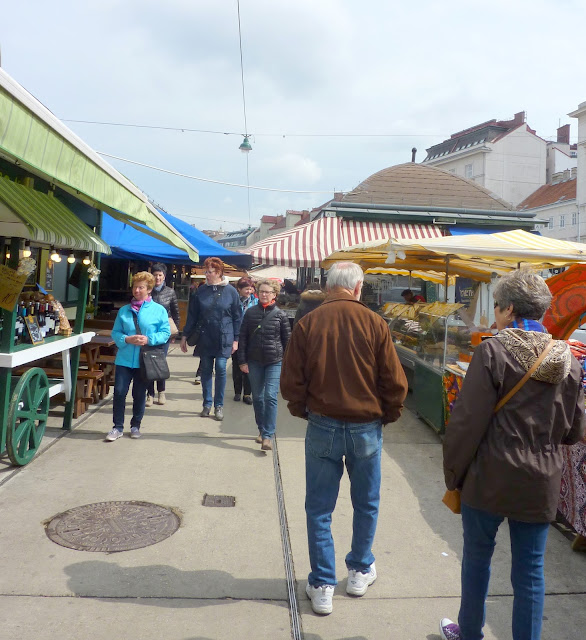This is a tightly packed commercial district that stands on the site of a medieval village that grew up in the Middle Ages around a small church. Today it's packed with cafes, clubs, restaurants, bookshops and clothing stores. It is also home to Vienna largest gay and lesbian community. The Wienzeile, a large street runs through the district, divided into the Rechte Wienzeile and the Richte Wienzeile: between the two sections of the street is the local market.

We walked along the Linke Wienzeile because we wanted to see two Jugenstil buildings designed by Otto Wagner, dating from 1899.
The first one, no. 38 is one of Europe's prime Art Nouveau jewels, and features on a 100 Euro gold coin. The corner is shaped as a quarter of a circle, which was a ground-breaking solution then.

It's main feature is the great golden ornaments decorating the white façade, done by Koloman Moser, another Austrian Art Nouveau artist and painter.

They are fabulous
looking closer

looking closer

Two wonderful female bronze sculptures decorate the roof.
The second one, at no. 40, is the Majolikahaus - unusually colourful and decorative while maintaining a simple shape. Its name comes from the Spanish tile tradition in Mallorca. The building is tiled all over with glazed red poppy tiles.

And a photograph that includes both buildings.
The building next to Majolikahaus is also interesting, but I could not find anything about it.
detail
The U-Bahn station is across the road
looking closer

detail.
We then walked along the market which dates back to the 16th century. The stalls are amazing
incense and water pipes
fruit
dried fruit and nuts
deli produce
herbs and spices
teas and infusions
macaroons
cured meats and lots more.

We liked the pedestrian traffic lights in Vienna - note the heart above the two people holding hands
and here's one for cyclists.
By then we were ready for refreshment and a sit down, so we chose Café Sperl, one of the traditional Viennese cafes,
which is situated on the edge of this tiny square.
Following our stop at Café Sperl we walked along Schadekgasse and reached
the Haus des Meeres, a reinforced concrete tower that was built in 1944 to bolster the city's defences. Today it's an aquarium and aviary.
A banner around the top, designed by Lawrence Weiner, proclaims 'Smashed to pieces... (In the Still of the Night)', a memorial against war and fascism.
























Those buildings at the beginning of your post are fabulous. I had seen photos of the bronze women before without information, so am delighted to know where they belong. The gold decorations brought to mind the work Rachel Whiteread did recently on the façade of the Whitechapel Gallery - not that her's was a fraction of the elaborate designs in Vienna.
ReplyDeletehttp://www.bbc.co.uk/news/entertainment-arts-18432744
I didn't make the connection with Rachel Whiteread's work on the Whitechapel Gallery, Olga, but you're right,- and both are very beautiful. The bronze women are wonderful: powerful sculptures and very much of that period.
Delete